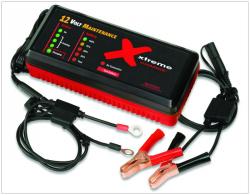Are Your Lead-Acid Batteries Ready For Spring?
Hibernation isn’t a restful sleep for 12V batteries. As many seasonal boaters unfortunately discover in the spring, it can be a nightmare.
If owners haven’t used a battery charger or maintainer with Pulse Technology over the winter storage period, they can anticipate sluggish or dead batteries during the spring equipment thaw out.All batteries, regardless of their chemistry, will self-discharge when not in use. The rate of self-discharge for lead-acid batteries depends on the storage or operating temperature. For example, a 125 AH battery that is stored for four months (16 weeks) during winter months without being charged or maintained will lose 80 amps of its 125-amp capacity. The battery will also suffer from severe sulfation buildup, inhibiting the plates from accepting and distributing a charge.
As good as lead-acid batteries are they all suffer from the same main failure mode‹80% of all lead-acid batteries fail due to the damaging effects of sulfation build up. If left unmanaged, sulfates found in the electrolyte will crystallize and root onto the battery plates and eventually result in premature battery failure. This is especially true with seasonally used boats and vehicles with short run times and high key off parasitic loads.
All lead acid-batteries consist of two flat plates‹a positive plate covered with lead dioxide and a negative made of sponge lead‹that are immersed in a pool of electrolyte (a combination of sulfuric acid (35%) and water solution (65%). Electrons are produced from the chemical reaction producing voltage. When there is a circuit between the positive and negative terminals, electricity begins to flow, providing connecting sources with power.
A lead-acid cell produces voltage by receiving (forming) a charge of at least 2.1 volts/cell from a charger. Known as Storage Batteries, lead-acid batteries do not generate voltage on their own/ they only store a charge from another source. The size of the battery plates and amount of electrolyte determines the amount of charge lead acid batteries can store.
Storage capacity is described as the amp hour (AH) rating of a battery. In a typical lead-acid battery, the voltage is approximately 2 volts per cell, for a total of 12 volts or a rating of 125 AH, which equates to the battery’s ability to supply 10 amps of current for 12.5 hours or 20 amps of current for a period of 6.25 hours.
Those who didn’t use a battery charger or maintainer over the winter months will typically discover a discharged, heavily sulfated battery when they go to use their boats in the spring.
To bring those batteries back to peak performance condition, PulseTech Products Corp., a national manufacturer of battery maintenance and charging products, recommends the following checklist:
* Give the battery case a quick clean to remove any dirt from the outside case.
* Clean terminal posts and make sure they are free of any corrosion. If significant, clean the terminal posts with a small wire brush to remove sulfate deposits and use dialectic grease or corrosion inhibiting spray to minimize future corrosion.
* Make sure the electrolyte levels are high enough. If levels are below the maximum line add distilled water (not tap water) up to the line. Not all batteries have a maximum fill line. If that’s the case with your battery, simply fill to 1/8² below the ring o plastic that extends into the cell. Never overfill the battery.
* Use a battery tester to ensure the battery has a minimum charge of 12.6 volts. If the charge is below that level you will need to charge the battery in a well-ventilated area. To ensure best performance use a smart charger featuring Pulse Technology for a week or more to dissolve the capacity robbing sulfates so the battery can be fully charged and retail full capacity.
* Not all batteries can be totally recovered. If a battery has a short circuit or physical damage, it is impossible to bring back.
About PulseTech Products Corporation
www.pulsetech.net
Maximizing battery performance while minimizing battery-related expenses for individuals, companies, fleets and military forces since 1994, PulseTech offers a full line of products that will help protect the environment from the hazards of lead waste from discarded lead-acid batteries.
